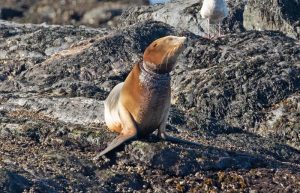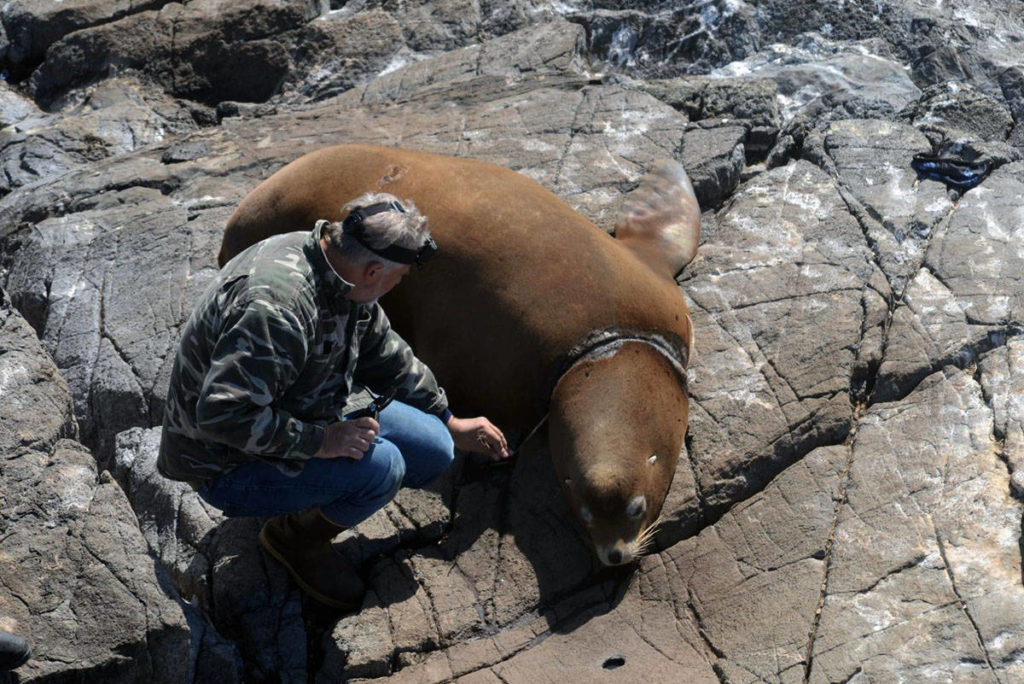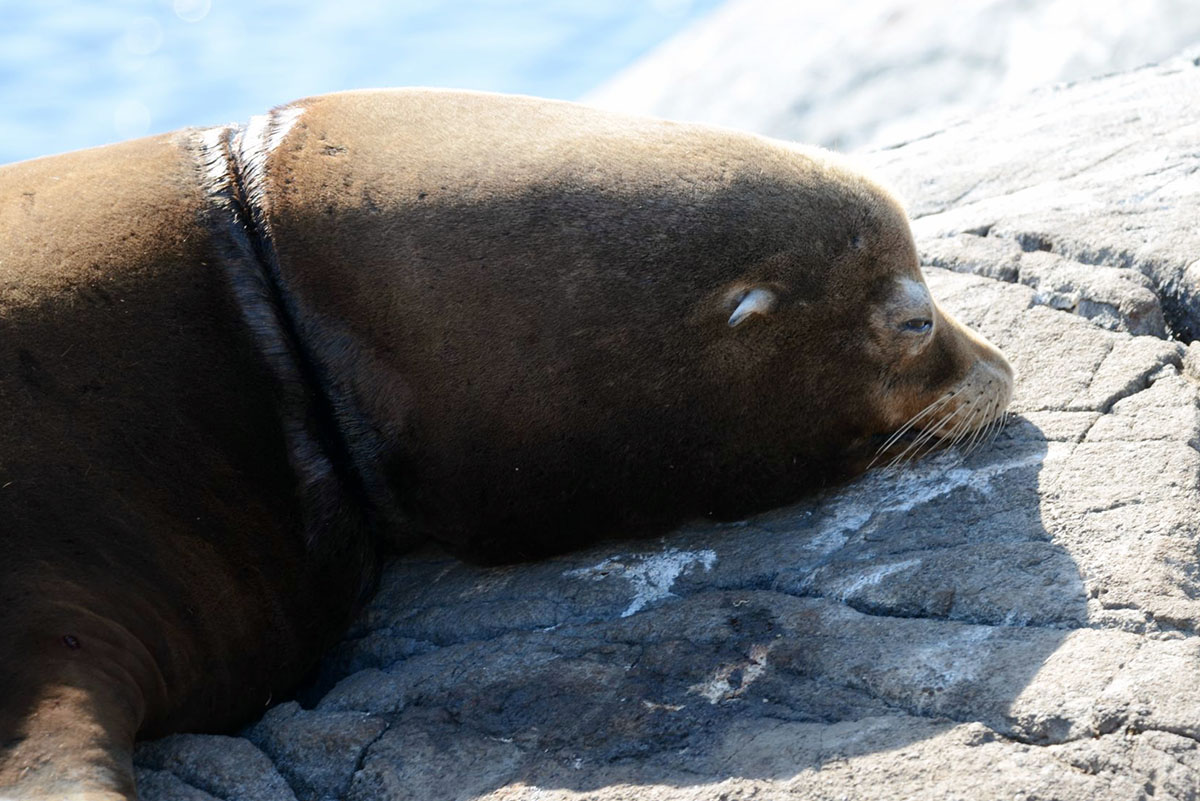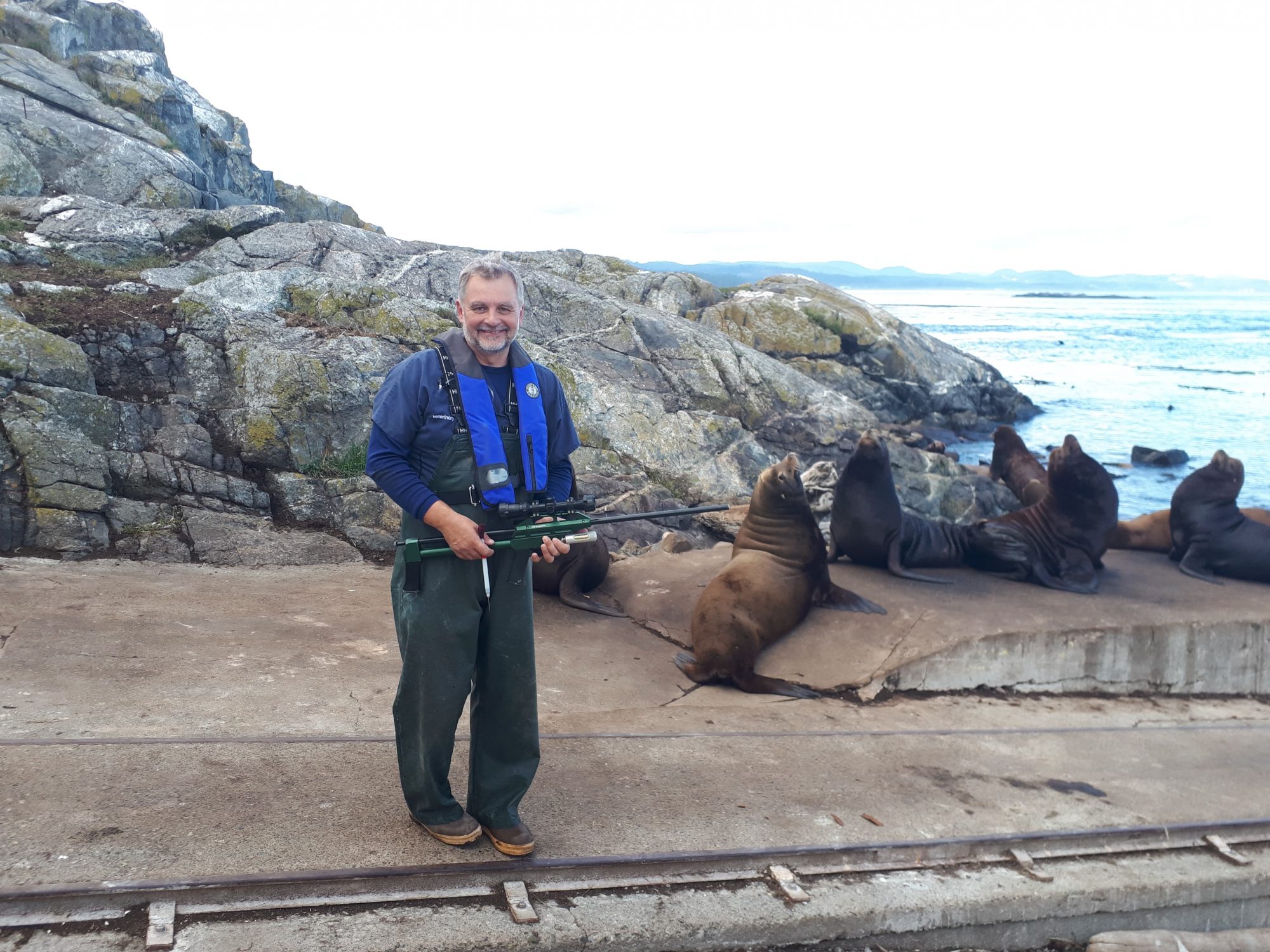The West Coast Environmental Law Organization published this comprehensive report on the Laws regarding marine protected areas. Chapter 4 deals with Ecological reserves and Race Rocks as an example. See page 166

Visitors: DFO was here today looking for the entangled California sea lion. Unfortunately they could not spot the animal.
Weather– Current: http://www.victoriaweather.ca/current.php?id=72
Weather–Past: http://www.victoriaweather.ca/station.php?id=72
Eagle Wing tours vessel 4 Ever Wild notified me of this sea lion in trouble photo by Val Shore. I have called DFO for help. Orca T49A2 49A3 in Race Pass going west. 
From The Goldstream Gazette  A Marine Mammal Rescue Centre veterinarian removes a plastic packing band from the neck of a Stellar’s sea lion at the Race Rocks Ecological Reserve on Sept. 10. (Courtesy of Mara Radawetz)
A Marine Mammal Rescue Centre veterinarian removes a plastic packing band from the neck of a Stellar’s sea lion at the Race Rocks Ecological Reserve on Sept. 10. (Courtesy of Mara Radawetz)
Plastic band removed from neck of Greater Victoria sea lion
Entanglement injuries in seals and sea lions a regular occurrence at Race Rocks Ecological Reserve
A sea lion trapped in human garbage has a second chance at life thanks to the sharp eye of a lighthouse-dwelling ‘ecoguardian’ at Race Rocks Ecological Reserve near Metchosin.
Mara Radawetz and Kai Westby, who live in the island’s lighthouse tower and monitor the reserve on behalf of Pearson College, called in back-up support when Radawetz spotted a California sea lion with a plastic packing band tightly bound around its neck on Sept. 1.
Over the days that followed, the duo spotted the animal again and watched it expressing clear discomfort as a result of the appendage.
“We could see that it was suffering, he would continually scratch at the infected area on his neck,” Westby said. “It had cut through his skin and created a kind of swollen, wet wound.”
The Marine Mammal Rescue Centre (MMRC), assisted by the Department of Fisheries and Oceans, responded to the call for help, but it would be a few days before the rescue could arrive by boat.
Fortunately, the rescue team arrived Sept. 10 and Radawetz was able to again spot the injured sea lion using a high-powered magnification lens from the top of the lighthouse, where the duo does a daily count of the island’s furry, feathered and blubbery visitors, which typically number in the thousands.
READ ALSO: Sooke Whale Watching spots a huge gathering of whales
“Being able to have that eye in the sky was instrumental in being able to successfully help this animal,” Westby said.
With a bird’s eye view, the pair guided MMRC veterinarian Martin Haulena to an area where he could prepare a dart gun with a tranquillizer. Rescue staff aided from the water and land, watching as Haulena crawled over the rocks and got into position, successfully tranquillizing the sea lion.
 A sea lion that had a plastic band removed from its neck at the Race Rocks Ecological Reserve wakes up from sedation.(Courtesy of Mara Radawetz)
A sea lion that had a plastic band removed from its neck at the Race Rocks Ecological Reserve wakes up from sedation.(Courtesy of Mara Radawetz)
In addition to removing the plastic band, the vet installed a tracking device and took a blood sample.
Radawetz and Westby said they see a sea lion or harbour seal with an injury due to human impact roughly once a week – and many of those animals don’t have a happy ending.
“We often see not only plastic entanglements but fishing line injuries on the sea lions and the harbour seals,” Radwetz said. The pair said they often see pinnipeds – seals, sea lions and walruses – that have swallowed a fish still on a fishing line, a meal that can cost the animal its life.
“It’s not always possible for us to help them,” Radawetz said.
While one lucky sea lion was able to swim free, Westby and Radawetz hope the incident resonates with people.
Westby added, “I really hope by sharing some of what we see here we can remind people that their actions have impacts and we are seeing those impacts here in Race Rock.”
In September 2019, a sea lion with almost identical injuries was rescued at the Race Rock Ecological Reserve. That animal had a plastic band embedded roughly two inches into its neck.
For more news from Vancouver Island and beyond delivered daily into your inbox, please click here.
READ ALSO: Steller sea lion with plastic around neck rescued on Vancouver Island
Veterinarian Martin Haulena from the Vancouver Aquariums Marine Mammal Rescue Centre attends to the injured sea lion.
photo: MARA RADAWETZ
A sea lion with a plastic packing band cinched around its neck was rescued near Race Rocks on Sunday, thanks to the combined efforts of rescue teams from Victoria and Vancouver.
The struggling sea lion was first spotted by Mara Radawetz, who lives in the decommissioned lightkeepers’ residence at Race Rocks, just off the southern tip of Vancouver Island. Radawetz, who monitors the Race Rocks Ecological Reserve with partner Kai Westby on behalf Metchosin’s Pearson College, saw the sea lion several times during the week in nearby Juan de Fuca Strait, and said the marine mammal was clearly in distress.
“He was scratching constantly at his wounds, which were cutting into his skin,” Radawetz said.
She contacted Fisheries and Oceans Canada and the Vancouver Aquarium’s Marine Mammal Rescue Centre, Canada’s only dedicated marine mammal rescue facility and one of the largest rescue facilities in the world, to help free the sea lion from the plastic packing band wrapped around its neck.
Two large Zodiac boats carrying the rescue team and several veterinarians arrived Sunday morning, and quickly found the sea lion, Westby said. After being given a tranquilizer injection by veterinarian Martin Haulena from the Marine Mammal Rescue Centre, the sea lion was brought onto the shores of Race Rocks and treated.
The plastic band was removed and tracking tags were attached to the animal’s front flippers. A blood sample was also taken, to assist with future studies. After being given a drug to reverse the effects of the tranquilizer, the sea lion was back swimming within minutes, Westby said. “It was great to see them help out an animal that was in such great pain.”
Suffering caused by man-made material such as plastic is an increasingly common problem among sea lions, Westby said. As permanent residents on Race Rocks, he and Radawetz see their share of injuries to sea lions.
“It can be pretty sad to see. They live for 20 years or 30 years, and as the animal grows, the band cuts through its skin. It becomes a really painful-looking wound.”
mdevlin@timescolonist.com
On November 4th and 5th the Marine Mammal Rescue Team was here to help out a couple California sea lions that were entangled. They arrive on the 4th and after doing a thorough search around the island there were no tangled sea lions around so we were afraid they may have left the area but thankfully the team stayed the night and the next morning they were able to find two sea lions who needed some help getting the garbage off of their necks. The first animal was on the north east side of island up on the rocks and Marty was able to dart him without him fleeing into the water. His tangle was pretty bad but thankfully the team was able to help him out before it got any worse. I’ve seen him hanging around the same spot since he’s been untangled.
The second one was in a bit of a tougher spot he was already half in the water so he jumped right in as soon as the dart hit him and went for a swim. The dart was very helpful in making him easier to spot as he swam around until he was sedated and the team was able to get a hold of him to help him out.
Overall it was a very successful trip and I am so glad the Marine Mammal Rescue team was able to come out here and help these guys out. I have not seen any new tangles since and I’m keeping an eye out for the two that are on the mend.
A team comprised of the DFO and Vancouver Aquariums Marine Mammal Rescue (MMR) came out to Race Rocks on September 16th to help the entangled sea lions we’ve spotted over the last few weeks. Leaving from Pedder Bay at 0900, they arrived in two RHIBs at the reserve shortly after. After observing the struggling animals over the last while and communicating information with MMR, they were a welcomed sight.
Right away we spotted three possibly entangled sea lions from the lighthouse (unfortunately none of these three being the animals we photographed previously). We then landed the team of vet techs and veterinarian Marty at the jetty to assess the situation. It was decided that one of the sea lions resting by the water between the guest house and the helicopter pad was our best rescue candidate.
Marty and a videographer from Vancouver Aquarium approached over the helicopter pad from the direction of ‘Camera 5’. They got into position and a shot was taken, but the tranquilizer dart bounced and the sea lion fled into the water.
From the lighthouse we were able to follow its movements and keep the team apprised by radio. There was uncertainty about whether or not it received a partial dose of the tranquilizer as it floated in strange positions/patterns. Moving around Race Rocks to the water beside the solar panel/generator building, it hauled out again and another shot at it was lined up from one of the boats. The angle wasn’t quite right, and it again fled into the ocean and couldn’t be spotted. It was around 1400, and everyone took a break to have some food.
After this, everyone considered calling it off as it was getting late and we couldn’t locate the animal. At the last moment, with both boats ready to head back to Pedder Bay, it was spotted from the lighthouse (resting on the rock mound on the NW point of Great Race Rock)! Tranquilizing was attempted from water, but the dart bounced again and landed in the water and was recovered. Here’s a short video of that:
After that, it ended up too far from the water to try another shot by boat, so in a final effort the one boat landed Marty and the team again while the other stayed on the water to support. With no cover available between him and the animal, Marty had no choice but to crawl about one hundred feet in order to take the shot.
We were able to capture the following footage of the sea lion being darted, going into the water, and then after a tense 20 minutes during which a pod of transient orcas appeared in the reserve (who sometimes eat sea lions), it was found! The team proceeded to cradle the animal between their vessels and remove the plastic band. Then, they injected a reversal drug to reverse the tranquilizer before letting it go.
Everyone was relieved to have successfully helped an animal in need. We have suggested that future disentanglement efforts might have a better chance if extended to overnight stays in the guest house, and perhaps coordinated and executed in a more timely manner in relation to the animal sighting(s). This time we were unable to find the original animals that we had previously spotted, since it took quite a while to organize the rescue attempt. A big thank you to everyone who came to help this sea lion and teach us about their work!
Check out rescue.ocean.org to learn more about the Vancouver Aquarium Marine Mammal Rescue program, and Ocean Wise.

Thanks to the rescue team, one more sea lion has a better chance of survival! (vet Marty holding the dart gun and dart used to tranquilize the sea lion)
See media coverage: https://www.bclocalnews.com/news/plastic-band-removed-from-neck-of-greater-victoria-sea-lion-2/
Weather:
Boats/Visitors:
Ecological:
Ed note: After two unsuccessful attempts to finalize the MPA designation for Race Rocks, I find it interesting to see this committee report so I have included the table of contents here , to see the complete document see this PDF FILE: included in the report are 25 recommendations.(.foporp14-e)
Link to the work done by the Race Rocks MPA advisory Board in two rounds of meetings– 1998-2010
TABLE OF CONTENTS
LIST OF MEMBERS
CONSERVATION OF MARINE BIODIVERSITY
C. Protected Areas: Definitions and Guidelines
D. Oceans Act Marine Protected Areas
CURRENT CRITERIA AND PROCESS USED TO IDENTIFY AND ESTABLISH OCEANS ACT MARINE PROTECTED AREAS
B. Science-Based Decision-Making
1. Selecting Areas of Interest
2. Community-driven Protection
3. Establishing a Marine Protected Area
C. Transparency With Regard to Consultations
1. Indigenous Rights and Interests
E. Plan to Achieve Canada’s Marine Conservation Targets
ENVIRONMENTAL IMPACTS OF MARINE PROTECTED AREAS
A. A Precautionary Ocean Management Tool
B. Maximizing Marine Biodiversity Benefits
SOCIO-ECONOMIC IMPACTS OF MARINE PROTECTED AREAS
A. Impacts on the Fishing Industry
2. Concentrating Fishing Efforts
B. Impacts on Subsistence Harvesting by Indigenous Peoples
C. Impacts on the Shipping Industry
ENHANCING THE OCEANS ACT MARINE PROTECTED AREAS’ ESTABLISHMENT PROCESS
A. Transparency: Ensuring a Comprehensive Consultation Process
2. Consultation Inclusiveness and Sharing of Information
2.2 Providing Relevant Information
2.3 Marine Conservation Led by Resource Users
2.4 Terminology and Concurrent Processes
3. Public Comment Periods and Proposed Regulations
B. Role of Science: Ensuring Science-Based Decision-Making
C. Protection Standards: Ensuring Marine Biodiversity Benefits
D. Recognizing Community and Indigenous Conserved Areas
E. An Integrated Process: Marine Planning
1. Planning Frameworks and Partnerships
2. Integrated Marine Planning Processes
APPENDIX C: TRAVEL TO CANADA – WEST COAST From May 28 to June 2, 2017
APPENDIX D: TRAVEL TO CANADA – EAST COAST From October 16 to 20, 2017
REQUEST FOR GOVERNMENT RESPONSE
SUPPLEMENTARY OPINION OF THE CONSERVATIVE PARTY OF CANADA
SUPPLEMENTARY OPINION OF THE NEW DEMOCRATIC PARTY OF CANADA